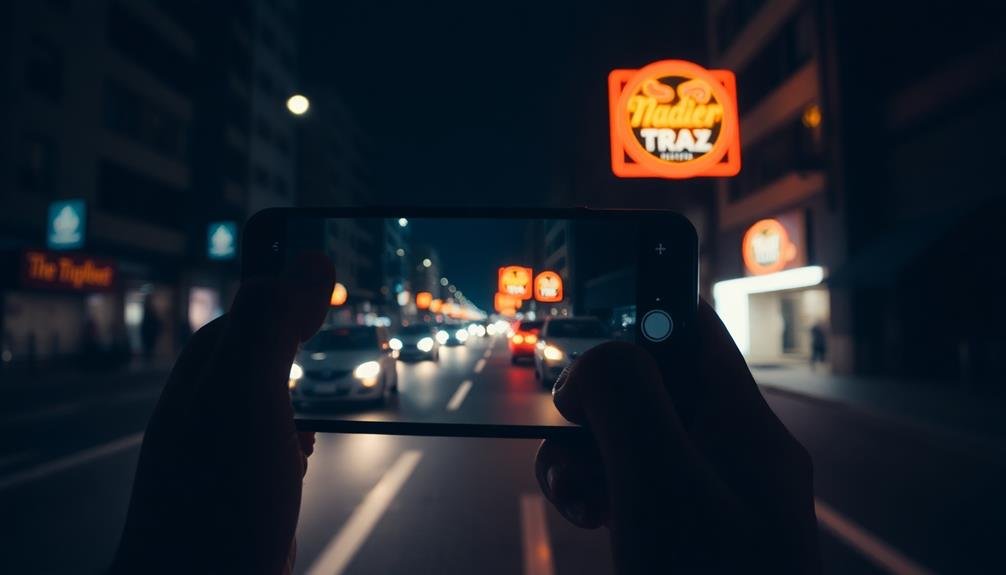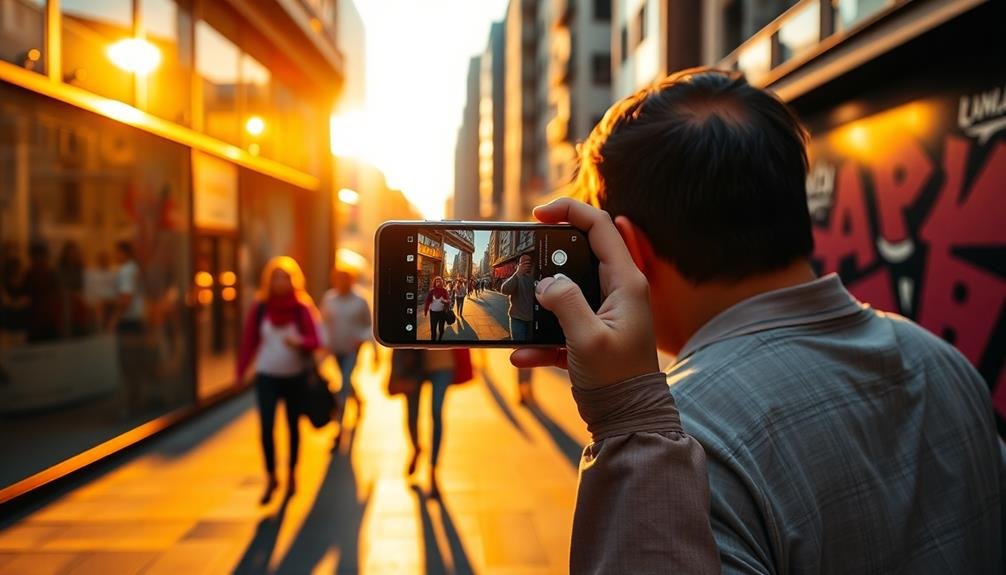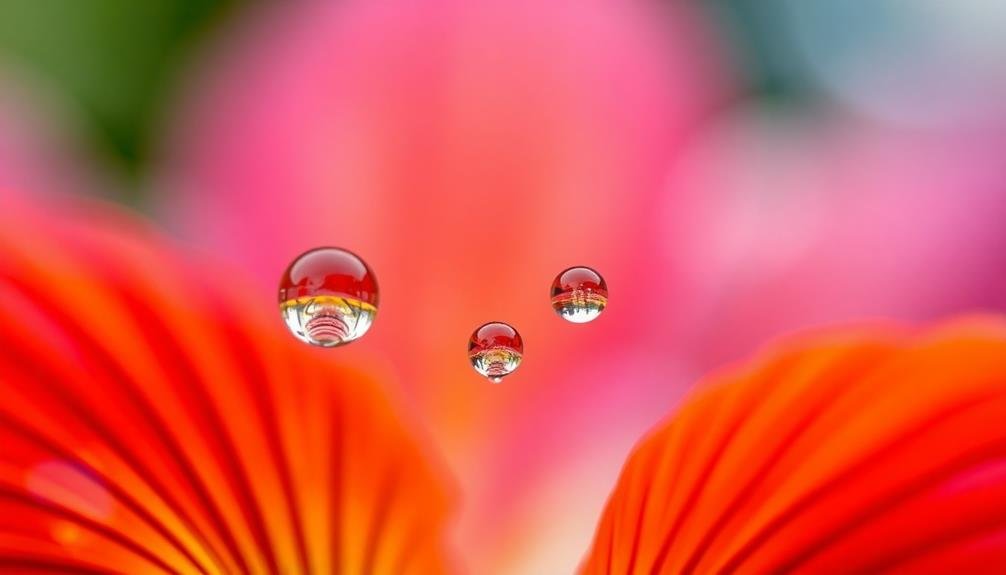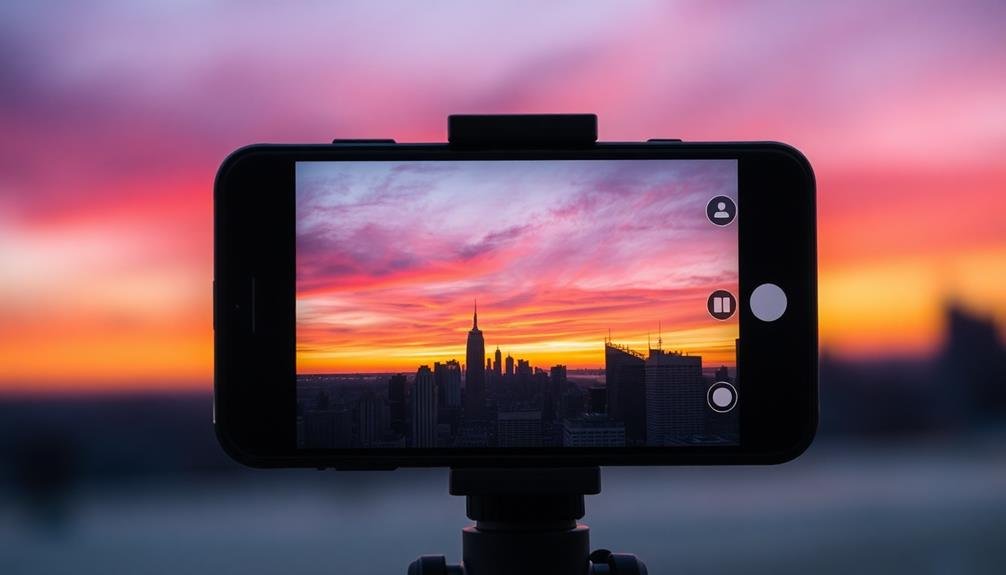To elevate your mobile street photography, focus on mastering three key settings. First, use aperture priority mode to control depth of field, isolating subjects or capturing broader scenes. Second, don't shy away from high ISO settings in low light conditions; modern smartphones handle noise well. Finally, embrace burst mode shooting to capture fleeting moments and fast-moving subjects. Start with a wide aperture (f/2.8 or lower), experiment with ISO levels up to 3200, and time your bursts just before peak action. These techniques will greatly boost your ability to capture compelling street scenes. Discover how these settings can transform your approach to urban photography.
Aperture Priority Mode

Mastery of aperture priority mode is essential for mobile street photographers. This semi-automatic setting allows you to control the depth of field while your phone's camera adjusts the shutter speed for proper exposure.
When shooting on the streets, you'll want to set a wider aperture (lower f-number) to create a shallow depth of field, isolating your subject from the busy background.
Start with f/2.8 or the widest aperture your phone camera offers. This setting works well for portraits and close-up shots, blurring the background and drawing attention to your subject.
For scenes with multiple subjects or when you need more of the frame in focus, increase the f-number to f/5.6 or f/8.
High ISO Settings

Embracing high ISO settings is essential for street photographers using mobile devices. When you're shooting in low light conditions or aiming to freeze fast-moving subjects, increasing your ISO can be a game-changer. Most modern smartphones allow you to manually adjust ISO settings, typically ranging from 100 to 3200 or higher.
Don't be afraid to push your ISO to 800, 1600, or even 3200 when necessary. While higher ISOs can introduce noise, many mobile devices have impressive noise reduction algorithms that help maintain image quality. Remember, a slightly grainy photo is better than a blurry one.
To make the most of high ISO settings, hold your phone steady and use burst mode to capture multiple shots. This increases your chances of getting a sharp image.
When editing, consider converting high ISO images to black and white, as this can mask noise and create a gritty, atmospheric look that suits street photography.
Experiment with different ISO levels in various lighting conditions to find the sweet spot for your device. With practice, you'll develop an intuition for when to crank up the ISO to capture those fleeting street moments.
Burst Mode Shooting

Street photography's fast-paced nature demands quick reflexes, and burst mode is your secret weapon. This feature allows you to capture multiple shots in rapid succession, increasing your chances of nailing that perfect moment. Most smartphones offer burst mode, typically activated by holding down the shutter button or using a specific gesture.
When using burst mode, consider these key points:
- Timing: Anticipate the action and start your burst just before the peak moment. This guarantees you don't miss the shot while giving you a range of images to choose from.
- Composition: Keep your framing consistent throughout the burst. Slight adjustments are okay, but maintain your overall composition to create a cohesive series.
- Storage: Burst mode generates many images, so make sure you have enough storage space on your device. Consider backing up or deleting unnecessary shots regularly.
After capturing a burst, review your images carefully. Look for the shot that best conveys the story or emotion you're aiming to capture.
Don't be afraid to experiment with different burst speeds and durations to find what works best for your style and subject matter.
Frequently Asked Questions
How Can I Keep My Phone Steady While Shooting in Low Light?
To keep your phone steady in low light, you can use these techniques: brace your elbows against your body, hold your breath while shooting, use a mini tripod, or lean against a stable surface. Don't forget to activate your phone's stabilization features.
What's the Best Time of Day for Street Photography?
You'll find the best light for street photography during the "golden hours" – just after sunrise or before sunset. However, don't limit yourself. Midday can offer harsh shadows, while nighttime creates unique moods. Experiment with different times for varied results.
Are There Legal Concerns When Photographing Strangers on the Street?
You should be aware of privacy laws when photographing strangers. In public spaces, it's generally legal, but you can't use images for commercial purposes without consent. Be respectful and prepared to delete photos if asked.
How Can I Make My Street Photos Stand Out on Social Media?
To make your street photos stand out on social media, you'll want to capture unique moments, use creative compositions, and develop a distinctive style. Edit carefully, use hashtags strategically, and engage with your audience to increase visibility and impact.
What Are Some Composition Techniques Specific to Mobile Street Photography?
You'll create standout mobile street photos by using leading lines, framing subjects with architecture, capturing reflections, and embracing negative space. Don't forget to experiment with unusual angles and play with shadows for added drama.
In Summary
You've now got the tools to elevate your mobile street photography. Remember, Aperture Priority Mode gives you control over depth of field, while high ISO settings help in low light. Don't forget to utilize Burst Mode for capturing fleeting moments. With these settings at your fingertips, you'll be ready to seize the essence of urban life. So get out there, start experimenting, and watch your street photography skills soar to new heights.





Leave a Reply